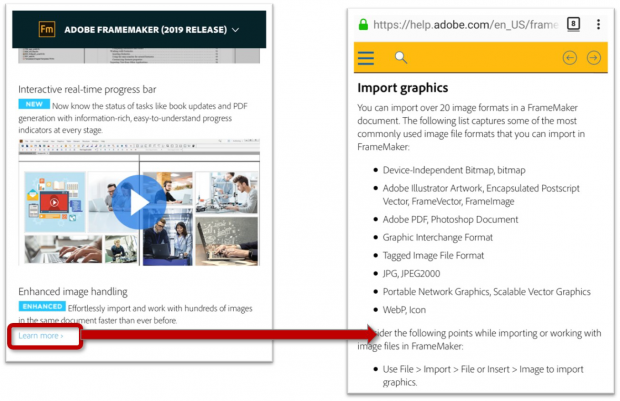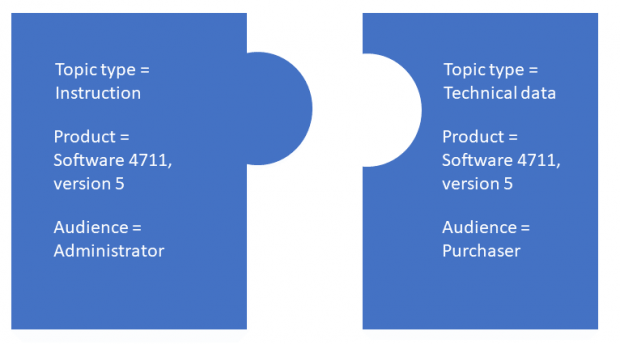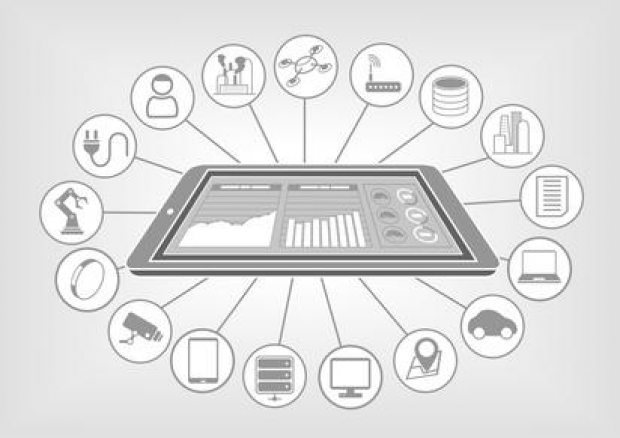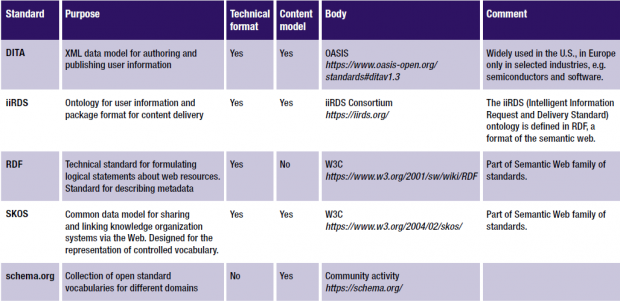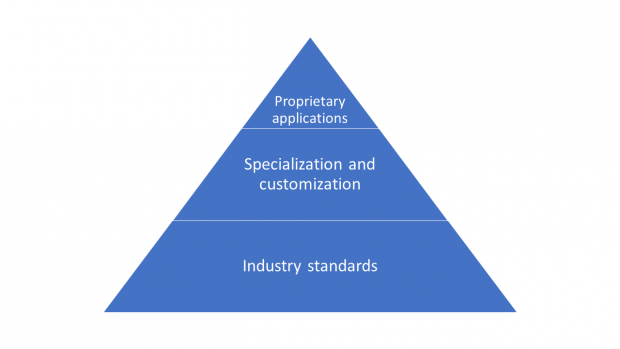The roles of standards and governance in engineering content. Why standards for multichannel distribution are more beneficial than you think
Zugehörige Leistung: Content-Engineering
This article was first published in STC intercom, the magazine of the society of technical communication, in November 2019.
About Intelligent Information and Omnichannel Distribution
The ongoing digitization of business requires us to rethink how we deliver user information. Technical documentation with hundreds of pages within one document is no longer viable. Today, we must deliver small content modules that show only the content that users need at a particular moment in time and in a particular context. Users need intelligent content or intelligent information instead of documentation.
Intelligent information dynamically adjusts to the context of the user and the use. It provides target-oriented information for all product lifecycle phases and various search and filter options. Intelligent information is modular, structured, and semantically enriched, and applications can evaluate it for specific usage scenarios.
From Multichannel to Omnichannel Distribution
Intelligent information is published and brought to users on various channels: as PDF, on the Internet, in social media, in mobile applications, or via chat bot or voice assistants. Based on the idea of single-source publishing, one piece of content is transformed into different output formats and can be presented in different media. In today’s interconnected world, the content that describes products is no longer split into silos like printed marketing materials, data sheets, websites, mobile apps, and technical documentation. The borders between the content types begin to blur and disappear as content is mixed on online platforms. Our users, of course, have never cared where a specific piece of information came from, as long as it has helped them with their question. Today, users access product information on multiple channels, sometimes even simultaneously. They expect easy, invisible transitions between content types. For example, users want to be able to retrieve more detailed information about an advertised feature (marketing material) from the technical documentation (see Figure 1).
Users expect the information in the different channels to be consistent regarding technical properties and terminology. Tone of voice and level of detail, however, might vary depending on channel and user. Content must be tailored to fit the user journey. A typical user journey could be to evaluate and compare product features and assess the quality of the documentation before making the decision to buy a specific product. During the journey, content must be findable and discoverable.
The difference between multichannel and omnichannel distribution is that we are no longer talking about content from a single source. Today, content is authored, edited, and published by multiple groups using different IT systems—typically by marketing, technical communication, product management, technical support, service, training, and sales. Each content group creates a different type of content. Keeping these different content types consistent and providing a smooth user journey is one of the biggest challenges today in content engineering. Another challenge is harmonizing technical formats and interfaces that are used to transport content between IT systems without creating a copy-and-paste hell for the authors.
How to Make Content Suitable for Omnichannel Distribution
So, how do we create content that is suitable for omnichannel distribution?
In short, we need to create content modules that are self-contained, usable, and reusable without any context. At the same time, the modules need to include all the information required to create context and to determine the purpose of the content. It’s like creating a jigsaw puzzle with pieces that have content on the front, hidden instruc- tions for use on the back, and little tabs for connecting to other pieces.
Properties of Omnichannel Content
Omnichannel content must have the following properties:
- Granular, meaning fragments and topics instead of documents
- Reusable for different audiences, contexts, and purposes
- Enriched with metadata for creating context and determining the purpose
- Portable, technically suitable for different media
- High-quality, fulfilling the information needs of the users—correct, understandable, appropriate, and accurate
- Distinct, separation between content and structure definition, content and layout, and content and metadata
The Importance of the Content Model
For an assembled jigsaw puzzle to look nice, all of the pieces need to follow the same design patterns. Otherwise the assembled image would look scrappy. The design of content is shaped by its terminology and structure. To reuse content across channels, we need to create content with harmonized content types that are tailored to specific information needs: instructions, procedures, feature descriptions, technical data, how-to videos, training units, exercises, and others. A content model with defined content types makes it easier for the authors to generate consistent content and, at the same time, makes it easier for the users to recognize the purpose of the content.
Within the content, consistent terminology helps readers to understand and grasp the information quickly. And although terminology management has a long tradition in technical communication, a lot of organiza- tions still have a long way to go to reach company-wide terminology management. How often have you seen a marketing brochure that speaks the same language as the user documentation?
The Importance of Harmonized Metadata
Let’s go back to our jigsaw puzzle image. To assemble the pieces, the tabs at the edge of the pieces need to fit the corresponding blanks of other pieces. Also, we need the information on the back side of the pieces—who needs this information and when? Tabs, blanks, and back-side notes are represented by metadata assigned to content modules, as shown in Figure 2. Metadata supports content selection based on queries and assembly of information into larger documents.
Just as terminology controls the language within the content, a harmonized vocabulary controls the language within the metadata. A corporate taxonomy is as important as terminology and content types. Otherwise, the search or filtering functions of the content delivery systems would have to consider all possible terms within metadata and relations between content modules. This would lower the quality of search results and make the assembled content less readable. By harmonizing metadata, we connect related content across discovery, access, and management.
How Do Standards Help Us?
Harmonizing content types and metadata is difficult enough when you have to do it in your own organi- zation. To achieve this kind of harmonization across organizations, you need strong nerves. As digitization progresses, content needs to be orchestrated not only within one organization but also across companies and their products. Consider a smart factory where machinery and devices from different manufactures are combined in common processes. As a result, the information about how to operate and maintain this “machine park” needs to be assembled and aggregated from different sources, as shown in Figure 3. Smart factories require intelligent information to be delivered to the user in a common application, regardless of the source and original authoring format. This requires standardized delivery formats and taxonomies.
This is where standards come into play. Standards help us overcome the obstacles that remain after harmo- nization by industry standards has reduced inconsistent content models and a variety of formats and interfaces.
Standards can refer both to technical solutions and methodologies. That means you can use a specific standard format or interface or a standard approach for developing your content model. Some standards are maintained by official standards organizations such as DIN, ISO, IEEE, and OASIS. Others are de-facto standards originating from individual companies.
Benefits and Disadvantages of Standards
Standards offer various benefits:
- Standards are usually developed by subject-matter experts from leading industry companies and reflect a lot of know-how and practical experience. Most standards are updated on a regular basis to reflect the developments within the industry.
- Standards come with documentation.
- Companies use standards as reference to harmonize their purchasing processes.
- Standards define specific quality criteria so that compliance implies good quality.
- Especially standards from international standard- ization organizations, such as ISO, are agreed upon within the industry.
There is a dark side, of course, because one size does not fit all. A standard must be generic to a certain degree, otherwise it won’t fit everyone. A standard represents a compromise between the individual interests of the contributors and stakeholders.
A good example of a compromise is the DITA standard. It contains different domains for specific purposes, such as the programming or learning domains. These domains reflect the interests of DITA users that need to write developer guides or training courses. Over time, attempting to meet the needs of everyone expands the core elements to such an extreme that the standard may become bloated and unwieldy for many potential uses.
Working in a standardization committee and developing a standard for any purpose can be a tedious task, because compromising takes more time and effort than just following your company’s roadmap. This is the reason why industry standards tend to lag behind recent industry developments.
Existing Standards for Technical Communication Content
With regard to technical communication content, there are already a number of standards that we can use (see Table 1). Some of them are mere technical standards defining formats or interfaces, while others also define semantics and content models.
Consider the requirements in “How to Make Content Suitable for Omnichannel Distribution”: from the list in Table 1, the DITA and iiRDS standards are most relevant for technical communicators:
- DITA provides both a file format and a semantic content type definition that are well suited for authoring content modules. Both make sure that all the jigsaw puzzle pieces follow the same design patterns.
- iiRDS provides standardized metadata that can be used to enrich content modules with context and purpose information. This information shapes the tabs, blanks, and back-side notes of our jigsaw puzzle pieces. In addition, the iiRDS package format allows content creators to deliver their content in a standardized way.
Both DITA and iiRDS provide machine-readable formats that can be processed and converted to fulfill the special publication needs of each channel and to feed search and filtering mechanisms. Both standards offer default specialization and customization mechanisms that enable companies to extend and adapt structures and vocabulary to their needs.
Challenges for Technical Communicators
Creating omnichannel content is a challenge that many companies face and most of them still have a long way ahead of them. Why? Their content is still stuck in silos and proprietary formats. Their systems do not exchange information or reuse content among each other. Their processes are not laid out for content collaboration. On the other hand, our industry is beginning to change. We can reduce effort and investments by using established standards as a basis for developing a harmonized content model for the organization. The particular needs of the company and the users that are not covered by the standard models can be implemented and specialized on top of the industry standards—see Figure 4. This also makes proprietary solutions leaner and easier to exchange.
Conclusion
To produce and distribute omnichannel content, organizations must adapt their content workflows, bridge their IT systems, and harmonize their content models. There are crucial benefits when we use industry standards as the basis for these new workflows.
- We leverage the knowledge of the experts who contributed to the industry standards.
- We make workflows and IT systems less dependent on specific vendors and systems, as well as more interchangeable.
- We enable content synchronization across organizations and products.
For technical communication content, there are a number of standards. DITA and iiRDS, in particular, are a good match, because together they cover content and metadata models. Organizations should invest in the development and maintenance of industry standards as part of their research and development activities to facilitate modern standards that provide a common ground for innovative content solutions.

